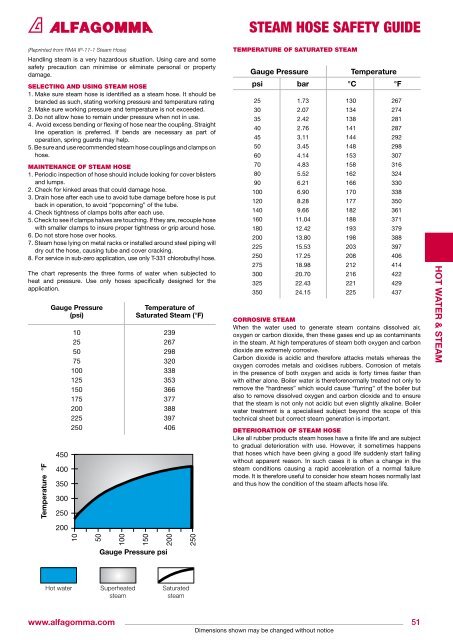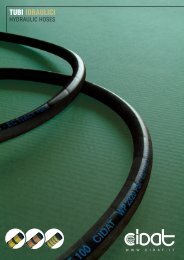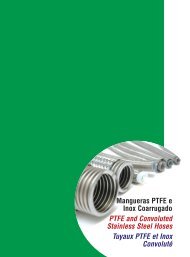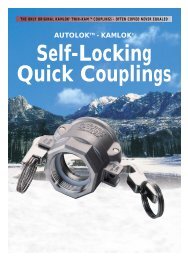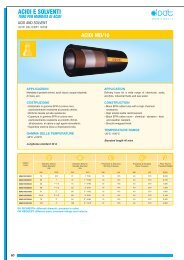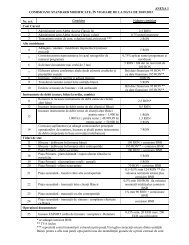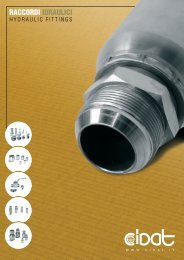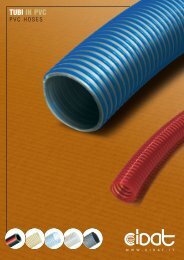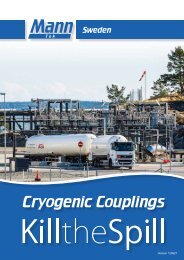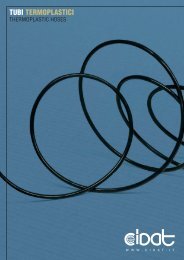water & liquids
water & liquids
water & liquids
You also want an ePaper? Increase the reach of your titles
YUMPU automatically turns print PDFs into web optimized ePapers that Google loves.
STEAM HOSE SAFETY GUIDE<br />
(Reprinted from RMA IP-11-1 Steam Hose)<br />
Handling steam is a very hazardous situation. Using care and some<br />
safety precaution can minimise or eliminate personal or property<br />
damage.<br />
SELECTING AND USING STEAM HOSE<br />
1. Make sure steam hose is identified as a steam hose. It should be<br />
branded as such, stating working pressure and temperature rating<br />
2. Make sure working pressure and temperature is not exceeded.<br />
3. Do not allow hose to remain under pressure when not in use.<br />
4. Avoid excess bending or flexing of hose near the coupling. Straight<br />
line operation is preferred. If bends are necessary as part of<br />
operation, spring guards may help.<br />
5. Be sure and use recommended steam hose couplings and clamps on<br />
hose.<br />
MAINTENANCE OF STEAM HOSE<br />
1. Periodic inspection of hose should include looking for cover blisters<br />
and lumps.<br />
2. Check for kinked areas that could damage hose.<br />
3. Drain hose after each use to avoid tube damage before hose is put<br />
back in operation, to avoid “popcorning” of the tube.<br />
4. Check tightness of clamps bolts after each use.<br />
5. Check to see if clamps halves are touching. If they are, recouple hose<br />
with smaller clamps to insure proper tightness or grip around hose.<br />
6. Do not store hose over hooks.<br />
7. Steam hose lying on metal racks or installed around steel piping will<br />
dry out the hose, causing tube and cover cracking.<br />
8. For service in sub-zero application, use only T-331 chlorobuthyl hose.<br />
The chart represents the three forms of <strong>water</strong> when subjected to<br />
heat and pressure. Use only hoses specifically designed for the<br />
application.<br />
Temperature °F<br />
Gauge Pressure<br />
(psi)<br />
450<br />
400<br />
350<br />
300<br />
250<br />
Temperature of<br />
Saturated Steam (°F)<br />
10 239<br />
25 267<br />
50 298<br />
75 320<br />
100 338<br />
125 353<br />
150 366<br />
175 377<br />
200 388<br />
225 397<br />
250 406<br />
TEMPERATURE OF SATURATED STEAM<br />
Gauge Pressure<br />
Temperature<br />
psi bar °C °F<br />
25 1.73 130 267<br />
30 2.07 134 274<br />
35 2.42 138 281<br />
40 2.76 141 287<br />
45 3.11 144 292<br />
50 3.45 148 298<br />
60 4.14 153 307<br />
70 4.83 158 316<br />
80 5.52 162 324<br />
90 6.21 166 330<br />
100 6.90 170 338<br />
120 8.28 177 350<br />
140 9.66 182 361<br />
160 11.04 188 371<br />
180 12.42 193 379<br />
200 13.80 198 388<br />
225 15.53 203 397<br />
250 17.25 208 406<br />
275 18.98 212 414<br />
300 20.70 216 422<br />
325 22.43 221 429<br />
350 24.15 225 437<br />
CORROSIVE STEAM<br />
When the <strong>water</strong> used to generate steam contains dissolved air,<br />
oxygen or carbon dioxide, then these gases end up as contaminants<br />
in the steam. At high temperatures of steam both oxygen and carbon<br />
dioxide are extremely corrosive.<br />
Carbon dioxide is acidic and therefore attacks metals whereas the<br />
oxygen corrodes metals and oxidises rubbers. Corrosion of metals<br />
in the presence of both oxygen and acids is forty times faster than<br />
with either alone. Boiler <strong>water</strong> is thereforenormally treated not only to<br />
remove the “hardness” which would cause “furring” of the boiler but<br />
also to remove dissolved oxygen and carbon dioxide and to ensure<br />
that the steam is not only not acidic but even slightly alkaline. Boiler<br />
<strong>water</strong> treatment is a specialised subject beyond the scope of this<br />
technical sheet but correct steam generation is important.<br />
DETERIORATION OF STEAM HOSE<br />
Like all rubber products steam hoses have a finite life and are subject<br />
to gradual deterioration with use. However, it sometimes happens<br />
that hoses which have been giving a good life suddenly start failing<br />
without apparent reason. In such cases it is often a change in the<br />
steam conditions causing a rapid acceleration of a normal failure<br />
mode. It is therefore useful to consider how steam hoses normally last<br />
and thus how the condition of the steam affects hose life.<br />
HOT WATER & STEAM<br />
200<br />
10<br />
50<br />
100<br />
150<br />
200<br />
Gauge Pressure psi<br />
250<br />
Hot <strong>water</strong><br />
Superheated<br />
steam<br />
Saturated<br />
steam<br />
www.alfagomma.com 51<br />
Dimensions shown may be changed without notice


